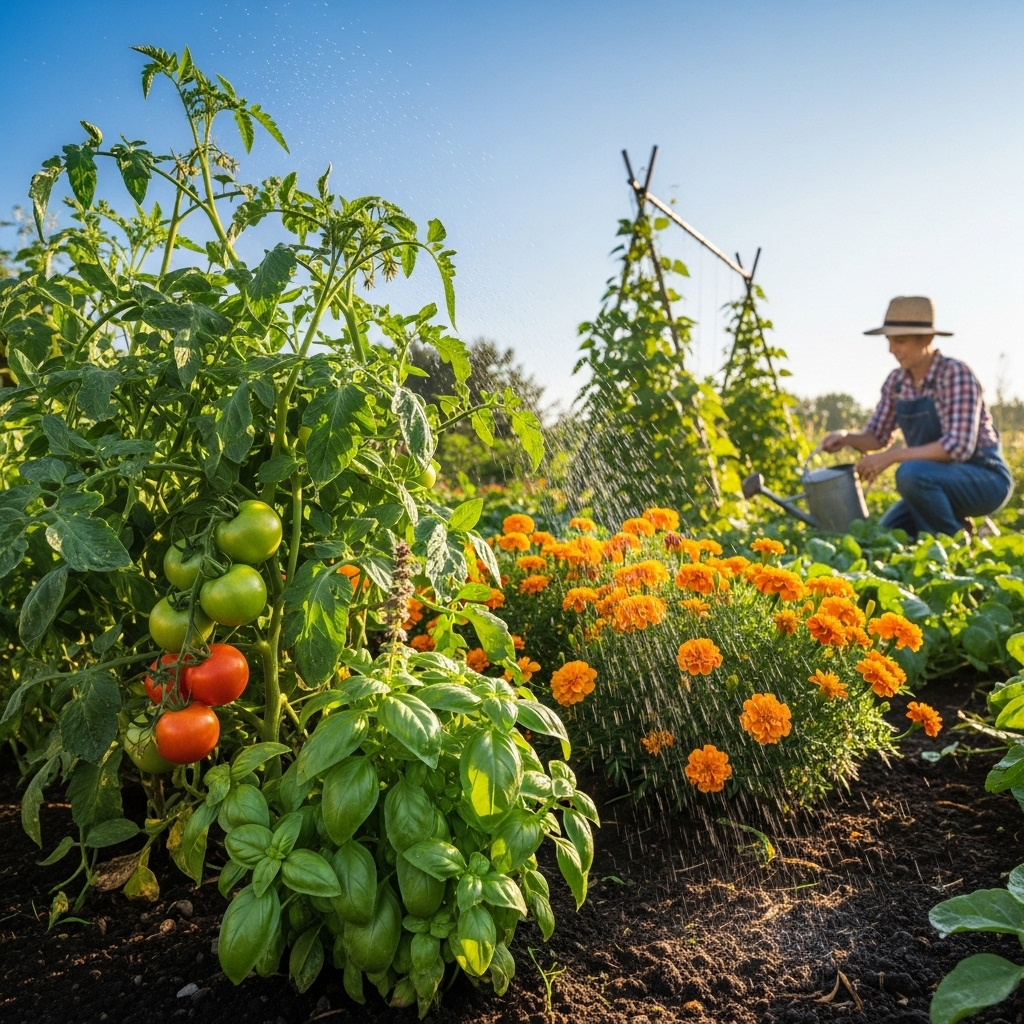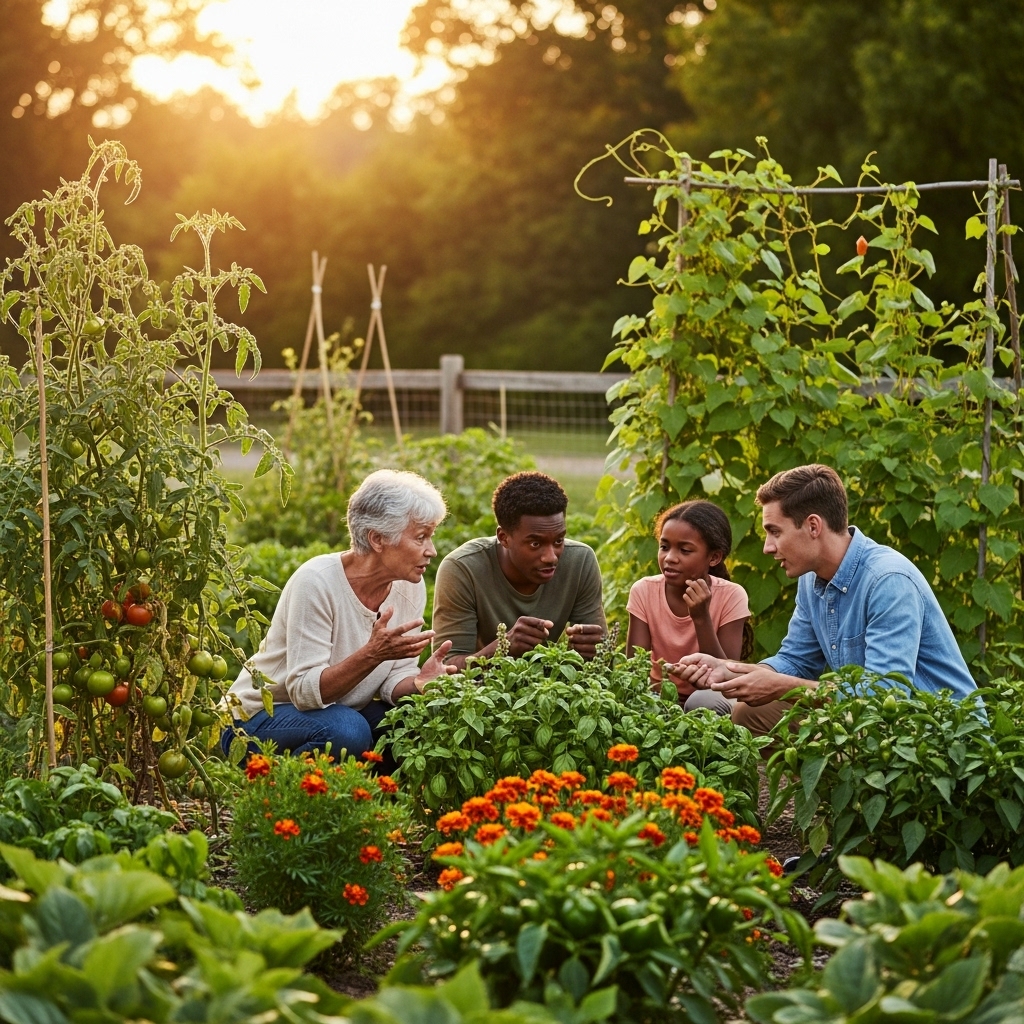Have you ever wondered how to boost your garden’s productivity? Companion planting is the secret sauce that can help your plants thrive together. Let’s dive into the world of companion planting to discover how to create the perfect planting combinations for remarkable results!
Understanding Companion Planting

As I ventured into gardening, I quickly realized that not all plants flourish in isolation. In fact, some plants have a magical synergy that enhances growth, deters pests, and improves flavor. This practice, known as companion planting, is an age-old technique that celebrates the natural relationships between different plant species. It’s fascinating to think that the right combinations can lead to a vibrant and bountiful garden.
The Science Behind Companion Planting
At its core, companion planting is rooted in the idea that certain plants can help each other grow. This happens through various mechanisms: some plants can repel pests that would otherwise harm their neighbors, while others can improve soil quality or provide necessary shade. Many gardeners, including myself, have embraced this method after witnessing its benefits firsthand. For instance, I’ve noticed that planting marigolds alongside my vegetables can significantly reduce pest problems.
But why does this happen? The key lies in the chemical signals and interactions that plants engage in. For example, some plants exude compounds that can deter insects or attract beneficial pollinators. Others can enhance nutrient uptake or provide necessary support for climbing plants. Understanding these relationships has transformed the way I approach my garden layout.
Common Companion Planting Pairings
Creating a companion planting chart is a fantastic way to visualize these relationships. Here are some of my favorite pairings that have yielded amazing results:
- Tomatoes and Basil: I’ve found that planting basil near tomatoes not only enhances the flavor of the tomatoes but also helps repel pests like aphids and whiteflies. It’s a classic pairing that every gardener should consider!
- Carrots and Onions: This duo works wonders in my garden. Onions help deter the carrot fly, while carrots can mask onions from pests that might target them. Plus, they’re both delicious in the kitchen!
- Cucumbers and Nasturtiums: Nasturtiums serve as a beautiful ground cover that attracts aphids away from cucumbers. I love the vibrant flowers that also make a lovely addition to salads.
- Beans and Corn: Planting beans alongside corn creates a natural support system. The beans climb the corn stalks while fixing nitrogen in the soil, benefiting both plants.
- Peppers and Spinach: I’ve observed that spinach provides some shade to pepper plants during the hotter months, allowing them to thrive without getting scorched.
Creating Your Companion Planting Chart
Now that I’ve shared some favorite pairings, let’s talk about how to create your own companion planting chart. I’ve found that a simple table format can be incredibly effective. Here’s how you can structure yours:
| Plant | Companion | Benefits |
|---|---|---|
| Tomatoes | Basil | Repels pests; enhances flavor |
| Carrots | Onions | Deters carrot flies; mutual benefits |
| Cucumbers | Nasturtiums | Attracts beneficial insects; ground cover |
| Beans | Corn | Climbing support; nitrogen fixation |
| Peppers | Spinach | Provides shade; improves growth |
Creating this chart has not only helped me organize my planting but has also made it easier to plan for the upcoming seasons. I recommend keeping it handy as a reference when deciding what to plant together. Over time, I’ve learned that observing the interactions in my garden can lead to even more insights, and I encourage you to do the same.
Resources and Tools for Companion Planting
To expand my knowledge of companion planting, I’ve relied on various resources and tools. There are countless books, websites, and apps dedicated to organic gardening and companion planting. Some of my favorites include:
- “Carrots Love Tomatoes” by Louise Riotte: This book delves into the benefits of companion planting with a wealth of practical advice.
- The Old Farmer’s Almanac: Their website offers an array of gardening tips, including a companion planting guide that is easy to navigate.
- Garden Companion Apps: There are numerous gardening apps that allow you to track your plants and see compatible companions based on your specific growing conditions.
As I continue my gardening journey, I find that companion planting is not just a technique but a holistic approach that respects the plant community. By understanding and utilizing these relationships, I can create a more productive and sustainable garden. So, let’s embrace the art of companion planting and watch our gardens flourish together!
Challenges in Companion Planting

While I find companion planting to be an incredibly rewarding practice, I’ve also faced my fair share of challenges. One of the first obstacles I encountered was misinformation. There’s a lot of conflicting information out there, and it can be confusing to discern what truly works. For instance, I’ve read about certain pairings that are said to be beneficial, only to find that they didn’t yield the expected results in my own garden. This experience taught me that what works for one gardener may not necessarily work for another, as local conditions and individual garden ecosystems play a huge role.
Another challenge is the timing and planning involved in companion planting. It requires a bit more foresight than traditional planting methods, as I need to consider the growth cycles of each plant. Some plants grow quickly, while others take their time. I’ve had moments where I planted companions that weren’t at the same growth stage, which led to crowded spaces or poor sunlight exposure for some plants. So, I’ve learned the importance of planning my garden layout meticulously and keeping a gardening journal to track my observations over time.
Additionally, pests can sometimes be unpredictable. Although I’ve noticed that certain companion plants help repel pests, there are times when they still make an appearance despite my best efforts. This has prompted me to explore integrated pest management strategies alongside companion planting. I’ve started to incorporate physical barriers like row covers and using organic pest deterrents to complement the natural benefits of companion planting.
Seasonal Considerations for Companion Planting
As I’ve progressed in my gardening journey, I’ve realized that the seasons significantly impact companion planting strategies. Different plants thrive at different times of the year, and this is crucial when planning my garden. For example, in the cooler months, I’ve found that leafy greens like spinach and lettuce can be planted alongside more robust plants like kale. The greens benefit from the shade provided by the larger plants, while the kale gets a chance to grow without being overwhelmed.
In the warmer months, I’ve experimented with planting heat-tolerant companions. For instance, I’ve found that planting okra with peppers works well, as both can handle the heat and thrive together. I also pay attention to how my plants interact with each other during these seasonal shifts, making adjustments as necessary. It’s a dynamic aspect of gardening that keeps me engaged throughout the year.
Experimenting with Companion Planting
One of the most enjoyable parts of companion planting for me has been the opportunity to experiment. I love trying new combinations to see what works best in my garden. Last summer, I decided to plant lavender alongside my vegetables. While I initially planted it for its aroma and beauty, I was pleasantly surprised by the number of bees it attracted. This led to increased pollination for my tomato plants, resulting in a larger yield than I’d previously experienced. It’s moments like these that make gardening so fulfilling.
I also keep a detailed gardening journal to document my experiments, including what I planted, how they interacted, and the results. This practice has not only helped me refine my approach but has also become a useful reference for future planting seasons. When I see a combination that works or doesn’t work, I make notes that guide my decisions in subsequent years.
The Role of Soil Health in Companion Planting
In my experience, the health of the soil plays a critical role in the success of companion planting. Healthy soil fosters thriving plants, allowing them to fully benefit from their companions. I’ve noticed that incorporating organic matter like compost and practicing crop rotation has improved my soil health dramatically. This, in turn, has led to more vigorous plant growth and better pest resistance.
When I set up new planting areas, I take the time to enrich the soil before introducing any plants. I’ve learned that taking care of the soil is an investment that pays off in the long run. The plants become more resilient and can provide support to one another more effectively. Moreover, maintaining soil health helps break the cycle of pests and diseases, allowing me to enjoy a more fruitful garden overall.
Community and Companion Planting
As I’ve delved deeper into the world of companion planting, I’ve also found that sharing this knowledge with fellow gardeners has been incredibly rewarding. I often participate in local gardening clubs and community events where we exchange tips and experiences. It’s fascinating to hear how others have successfully implemented companion planting in their gardens, and I’ve picked up invaluable insights from their experiences.
I’ve even organized small workshops where I teach others about the benefits of companion planting and share my own successful combinations. It’s heartening to see new gardeners embrace this technique, and I love hearing about their successes as they apply what they’ve learned. Being part of a community of like-minded individuals not only enhances my gardening experience but also reinforces the idea that gardening is a shared journey.
Final Thoughts
As I reflect on my experiences with companion planting, I’m continually amazed by the depth and complexity of nature’s relationships. This practice has transformed my gardening approach, making it not just about growing plants but about nurturing a balanced ecosystem. By observing, experimenting, and sharing with others, I’ve created a more resilient garden that thrives on the synergy of its components. I hope you feel inspired to explore companion planting and discover the joys it can bring to your own gardening adventure!
